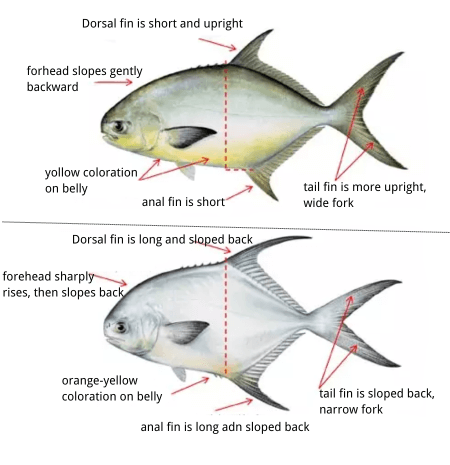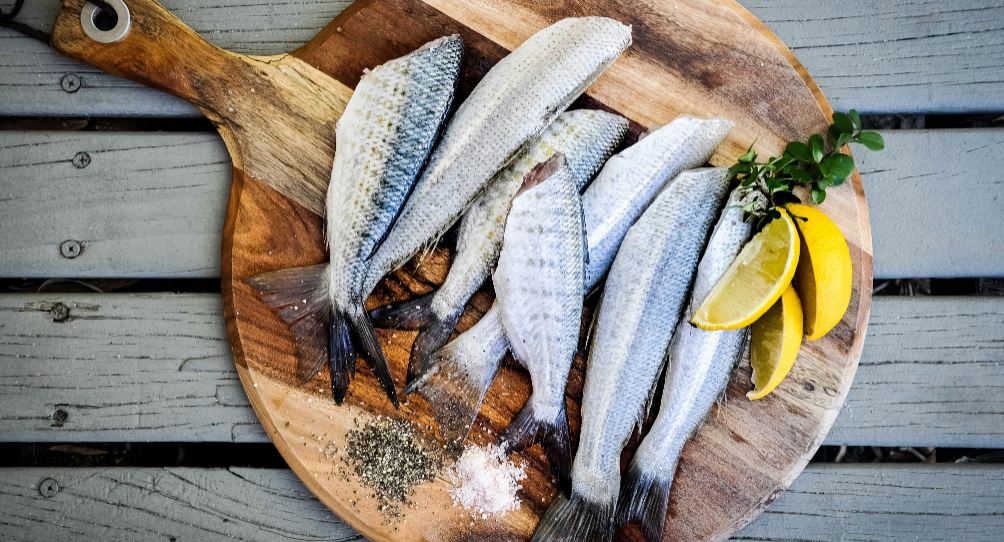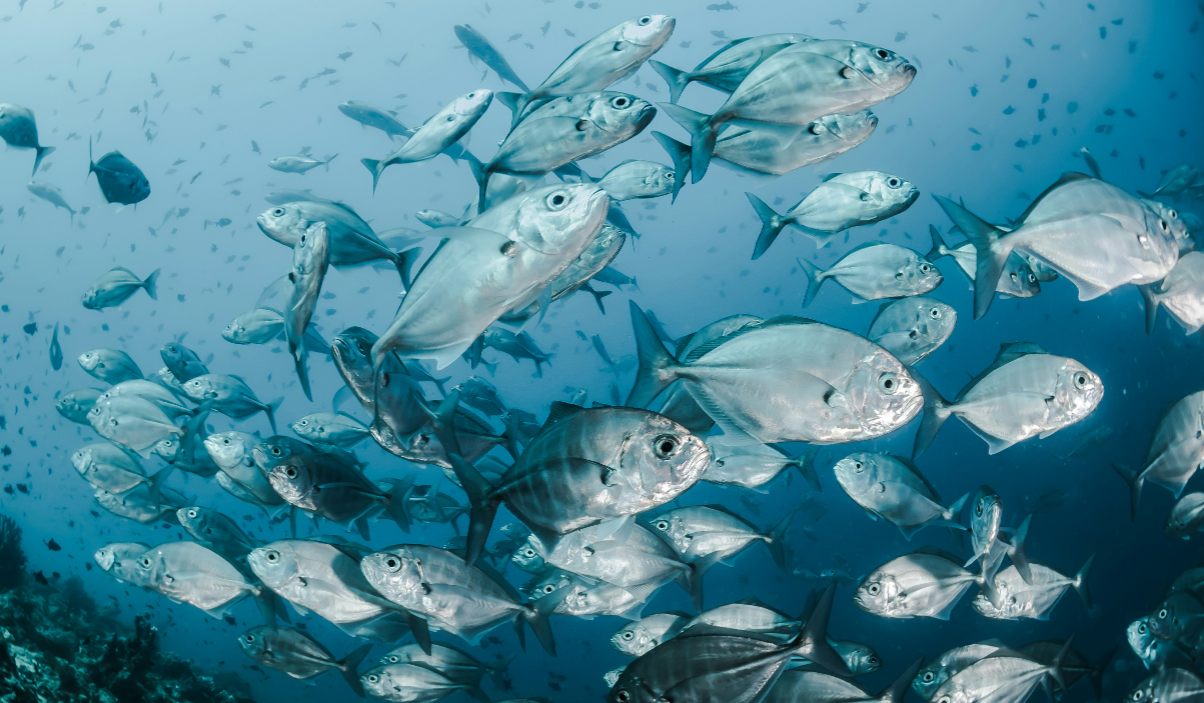Do you feel like hooking a glistening pompano or a giant permit? These prized fish, both of the jack family, may look alike at first glance, but beware they are not the same! These differences mean that specific fishing techniques need to be employed to effectively land your prize. Here, we clear up the confusion and let you understand the difference between Pompano vs permit.
We will make you alert on each species of fish so that when it comes to fishing you know when it is the best time to fish and the best lures to use. So, catch the fish of your desire whether it might be the yummy pompano or the tough fighting permit.
Pompano Vs Permit: Comparison
Pompano and Permit – both belonging to the Jack family have firm white flesh and make for a compelling fight.
However, some features set them apart based on which you can differentiate between them. Okay then, let’s dive right into it and learn how to quickly distinguish these silvery stars of the sea.
How to Quickly Identify Pompano vs Permit?
- Size: Permits are whoppers, reaching up to 40 pounds compared to the pompano’s more modest 8 pounds.
- Head Shape: Permits have a distinctive bump on their head, while pompanos have a smoother slope.
- Fins: Count the soft rays in the dorsal and anal fins. Pompano generally has more (22-27 vs. 17-21 for permit).

Top one is Pompano and bottom one is Permit
Physical Characteristics
Pompano: A laterally compressed form with a greenish-grey dorsum that fades to silver on the sides and a glaring yellow ventrally. Their dorsal and anal fins often have a yellow hue to them.
Permit: It has a larger body that shines silver coupled with a dark or blue-black shade on its back. Larger specimens may have orange or gold around the breast, making them appear brighter than other specimens. The adult also has a black spot behind the pectoral fin which to some extent can be of use in identification.
| Feature | Pompano | Permit |
| Size | Up to 8 lbs | Up to 40 lbs |
| Body Shape | Deep and thin | Wider |
| Head Shape | Smooth slope | Bump on head |
| Fin Color | Yellowish | Silvery or yellow (may have black spot) |
| Fin Rays (dorsal/anal) | 22-27 / 20-23 | 17-21 / 16-19 |
Pompano Vs Permit: Which One Tastes Better?
Some people said that Pompano tastes better. But the “better” tasting fish depends on your preference.
Pompano takes the crown for raw preparations, while Permit might need some extra TLC but offers a bolder taste. Whichever you choose, prepare to enjoy a delicious and nutritious seafood experience!
But when it comes to taste, there’s a subtle difference.
Can You Eat Them?
Absolutely! Both pompano and permit are prized for their culinary value. However, it’s important to check local regulations regarding permit fishing, as they are sometimes considered gamefish with catch-and-release restrictions.
Which One Tastes Better?
- Pompano:The champion of sashimi! Its soft, delicate flesh with a slightly sweet flavor shines when served raw. It’s also excellent pan-fried, grilled, or baked, offering a mild, flaky texture.
- Permit: While delicious, a permit can be slightly gamier and firmer than pompano. It benefits from marinades or sauces to enhance its flavor and requires a bit more finesse when cooking to avoid drying out.
What Are The Nutritional Values of Pompano and Permit?
Permit and pompano are considered to have lean meat with about 20 grams of protein and below a gram of fat in a serving that is 3 ounces. They also contain desirable vitamins and minerals which are so important in the healthy functioning of our body.
If you’re a supporter of seafood, then you should try Pompano as it is densely laden with Selenium, which is a potent antioxidant element. It helps in providing a proponent to the immune system and improves cell performance.
Permit, on the other hand, is a good source of vitamin B12 that is used in the body for nerve health and red blood cell formation.
What Is The Best Way To Cook Them?
When it comes to cooking these delicious fish, here are some tips:
Pompano Recipe
- Because of its softness, It is recommended that it should be cooked briefly to retain as much moisture as possible.
- When it comes to having the skin of the dish crispy on the outside and the inside part well done, pan-searing is the best way to go.
- Place the pompano fillets on a well-seasoned skillet then heat them on medium-high heat, add butter or olive oil, and
- Flip the fillets once to cook for 2-3 minutes depending on the thickness.
- Another is using high heat and boiling to try and bake it.
- Heat the oven to 400°F (200°C) and roast the pompano fillets for about 10-12 min or until it is still a little pink in the middle.
Permit Recipe
- Marinating or using sauces can enhance the permit before cooking for particular parts, mainly the thicker ones.
- One can even add some liquid marinade of lemon juice, olive oil, fresh herbs, and garlic to it.
- Permit can be grilled or baked and it can also be broiled but take care that the fish does not get dry.
- For grilling, preheat the grill to at least medium-high and then grill the permitted steaks for about 3-4 minutes on each side for the desired level of doneness.
- For baking, set your oven to 375F, 190C, and bake the Permit steaks for about 15-20 minutes or until they are flaky.
- Permit can also be prepared by broiling it to make a quick preparation. Broil your permit steaks in a high flame for 5-7 minutes on each side or until done.

How To Fish Pompano And Permit?
Pompano and Permit may be cousins, but their fishing tactics require distinct approaches. Here’s a breakdown to help you conquer these prized catches:
How to Fish Pompano?
- Employ a slow and steady retrieve, keeping your rod tip low to the water.
- This presentation minimizes resistance and makes your bait look more natural.
- As you reel, gently bounce or twitch the rod tip to simulate a fleeing crustacean.
- Pompano are ambush predators, so be observant. If you see a flash of silver or feel a sudden weight, set the hook quickly but with a light touch.
- Pompano have a surprisingly strong fight for their size, so be prepared to play the fish patiently, letting it run when necessary to avoid pulling the hook free.
Fishing Tips For Pompano
- Time to Shine: Early mornings (dusk to mid-morning) and late afternoons (evening to dusk) are prime feeding times when the water is calm.
- Conditions: Look for clear, calm waters with light swells on sandy beaches or flats. Pompano tends to burrow in the sand during rough surf.
- Lure Selection: Mimic their natural diet of crabs and shrimp with small jigs (1/8 to 1/4 oz), shrimp flies, or sand fleas. Light bait rigs with live sand fleas or bloodworms are also highly effective. Choose light tackle (7-8 foot rod, 20-30 lb braided line, and a 10-15 lb fluorocarbon leader) as pompano have a delicate bite.
How to Fish Permit?
- Employ a slow and deliberate retrieve, mimicking the movements of a crab scuttling along the bottom.
- For fly fishing, cast around structures or near crab holes, letting the fly sit enticingly in the current. When a permit shows interest, don’t jerk the rod! These curious fish may nudge or follow the fly for some time before committing to a strike.
- Be patient and allow the permit to take the fly fully before setting the hook. Permit are powerful fighters, known for long runs and bursts of speed.
- Use your rod’s drag to control the fish’s powerful surges, but be prepared to give line when necessary to avoid breaking the leader.
- Fight the fish methodically, slowly tiring it out until it yields. Landing a permit is a true test of skill and perseverance, but the reward of catching this magnificent fish is well worth the effort.
Fishing Tips For Permit
- Time to Strike: Permits are known for their unpredictable feeding patterns, but generally show increased activity during high tides and calmer waters, particularly in the afternoon.
- Conditions: Target areas with flats, oyster beds, and structure breaks near inlets or passes where crabs, their primary food source, congregate.
- Lure Selection: Due to their size and power, Permit requires heavier tackle (9-10 foot rod, 40-50 lb braided line, and a 40-80 lb fluorocarbon leader). Fly fishing enthusiasts can use large crab flies or Clouser Deep Minnows. For conventional tackle, opt for large jigs (1/2 to 1 oz) or weedless spoons that resemble crabs. Live crabs are the ultimate bait for Permit but be prepared for a long wait and potential regulations regarding their use in your area.
Conclusion
Although both pompano and permit are considered desirable catches, knowing when to target either is crucial when fishing. Whether it’s the light and sweet taste of pompano or the battle to catch a permit, this guide provides you with the information necessary to aim at these silvery stars of the sea.
So, take your fishing rod, select your strategy, and get ready for a tasty outcome or an exciting fight!




















Leave a reply